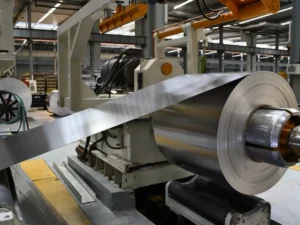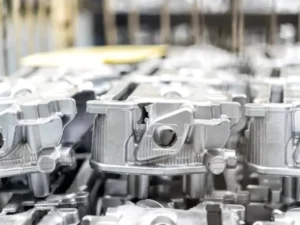In the last article, we discussed the melting point of aluminum metal. However, pure aluminum is rare. Engineers and manufacturers generally prefer using aluminum alloys. The reason is that added alloy elements give aluminum preferable properties. However, the melting point of aluminum alloys is least understood.
It is not wrong to say that aluminum metal has revolutionized the metal industry. Do you know why? Because of the endless benefits and properties of shaping and manufacturing many materials. Above all, there is no risk of corrosion. However, when used with alloy elements, its strength and durability become matchless.
However, the melting point of aluminum alloys differs from that of pure aluminum. Therefore, manufacturers want an exact melting point. It helps them know where they should utilize these aluminum alloys. However, this topic is least discussed, and everyone focuses on only aluminum. So, let’s dive in and discuss the melting of aluminum alloys.
What Is The Melting Point?

Let’s not use a bunch of confusing words in this article. Instead, I want to help you understand the topic from the basics. As you know, metal is most often in a solid state. Changing its form and shaping it into any other is challenging, right? But melting points can help us do this.
The melting point is the temperature that helps convert the solid metal into liquid form. Simply put, it is the heating point, as a metal cannot sustain itself and melts. Whenever the melting temperature reaches, the solid becomes liquid. Every metal has its melting depending on its strength.
Metal and every solid item that nature produces has a specific melting point. The manufacturers use aluminum alloys for different purposes. Knowing the exact melting point is crucial for them. If they don’t know and use aluminum in places with too high temperatures, it will melt and not fulfill their needs.
Melting Point of Aluminum in Relative to its Alloys
As I said, the temperature at which aluminum and its alloy metals vary from each other. For a detailed understanding of the melting point of aluminum, visit our other article. Let me give you a brief overview of aluminum’s melting point relative to its alloys.
Aluminum is a rigid metal. That is why it has a higher melting point. In its pure form, aluminum’s melting point is 660.32 degrees Celsius( 1220.58F). But when aluminum is alloyed with another element, its melting changes (either increases or decreases depending on the alloy element.).
Let me explain it to you. Suppose you have pure aluminum. It will melt at 660.32°C. But if a very small amount of impurity is present in it, its melting point will deviate from this range. That impurity is very small, but it still impacts the melting point. Now, imagine the presence of a whole new element along with aluminum.
The strength and melting point of the alloy elements affect the overall melting point. For example, copper has a high melting point. When this is added to aluminum as an alloy, it increases its temperature. This is how the temperatures of pure aluminum and its alloy vary from each other.
You might wonder why we need to use alloys and complicate the melting points. Metal engineers and manufacturers create aluminum alloys to achieve the desired properties. The alloy element can increase strength, corrosion resistance, and durability. The difference in alloy composition results in a melting point different from that of pure aluminum.
What Is The Melting Point Of Aluminum Alloys?
The melting point of aluminum alloy is not specific or fixed. Different alloys of aluminum have different melting points. It majorly depends on the alloy element. For example, aluminum alloy with copper has a high melting point. Similarly, its alloy with silicon has a low melting point.
The alloy element is of the utmost importance. It imparts its properties to aluminum when it is in alloy. If an added or alloyed element has a high melting point, the alloy will have a high melting point. Not only the melting point but every alloy property goes into the aluminum alloy. Let me explain it with an example.
Pure aluminum has slightly compromised corrosion resistance. However, when alloyed with magnesium, it becomes excellent in terms of rust protection. This is due to the property of added magnesium. In simple words, magnesium imparts corrosion resistance to the whole alloy combination.
Types of Aluminum Alloys and Their Melting Points
Aluminum alloys are divided into two categories: wrought and cast alloys. These two are very dominant in many industries. Moreover, they have a melting point range rather than a fixed melting point. Let’s explore the melting points of these alloys.
1- Wrought Alloys
Wrought alloys are known due to their excellent mechanical properties. They can be shaped, formed, and processed through different processes, such as rolling, forging, or extruding. Their melting points are different from those of pure aluminum. Here are different wrought aluminum alloys with specific melting points.
- 2024 Aluminum Alloy: 500-635°C (935-1180°F)
- 3003 Aluminum Alloy: 640-655°C (1190-1210°F)
- 5052 Aluminum Alloy: 605-650°C (1125-1200°F)
- 6061 Aluminum Alloy: 580-650°C (1080-1205°F)
- 7075 Aluminum Alloy: 475-635°C (890-1175°F)

Let’s drill down further and discuss the properties of those wrought alloys.
2024 Aluminum Alloy
2024 alloy is very popular because of its use in the aircraft industry. Most parts of the pistons and cylinders are made of it. Its melting temperature is 500-635 degrees Celsius. In terms of the Fahrenheit Scale, it is 935-1180 degrees Fahrenheit. Technically, it has an Aluminum metal melting point of less than pure aluminum. Here are the top applications of this alloy:
- High-strength structural applications
- Aircraft wings
- Gears and shafts
- Cylinders and pistons
3003 Aluminum Alloy
3003 alloy of aluminum is famous for its use in various industries. Its melting temperature is near pure aluminum, and it has very high strength compared to other metal alloys. Its melting temperature is 1190-1210 degrees Fahrenheit. In the Celsius scale, it is 640-655 degrees. Its top applications are as follows:
- Truck and Trailer parts and cabinets
- Heat Exchangers
- Fuel tanks and piping
- Chemical equipment
5052 Aluminum Alloy
If you wish to use aluminum in the Hydraulic system, 5052 aluminum alloy has been a top choice for decades. This is because of its high strength and properties, which are helpful for heavy hydraulic systems. Its melting point is 605-650 on the Celsius scale and 1125 to 1200 on the Fahrenheit scale. The application of this alloy includes:
- Pressure vessels
- Fencing
- Appliances
- Marine equipment
- Hydraulic tubes
6061 Aluminum Alloy
6061 is another Aluminum alloy with different physical and temperature properties. Because of its strength and robustness, manufacturers often use it to build different products. The melting temperature ranges from 580 to 650 degrees Celsius. On the Fahrenheit scale, it is 1080 to 1205 degrees. This aluminum alloy has the following applications.
- Automotive parts
- Building products
- Furniture,
- Bicycle frames
- Railroad cars
- Piping
7075 Aluminum Alloy
7075 has the lowest melting point compared to other wrought aluminum alloys. Its melting temperature range is 475 to 635 degrees Celsius or 890 to 1175 degrees Fahrenheit. Due to its low melting point, 7075 is helpful for aircraft and gearing products. Here is a quick overview of its applications.
- Missile parts
- Aircraft wings
- Gears and shafts
- Worm gears
2- Cast Alloys
Cast alloys of aluminum are more complex than wrought alloys. The reason is that the production process involves heating aluminum and pouring it into molds. So, cast alloys are available in different shapes. Here is the list of famous cast alloys:

- A360 Aluminum Alloy: 557-596°C (1030-1100°F)
- A380 Aluminum Alloy: 538-593°C (1000-1100°F)
- A413 Aluminum Alloy: 574-582°C (1070-1080°F)
- B390 Aluminum Alloy: 510-649°C (950-1200°F)
A360 Aluminum Alloy
A360 is a cast alloy of aluminum with a varying range of temperatures. It has applications in various tools, gears, and irrigation systems. Its melting temperature is 1030 to 1100 degrees Fahrenheit or 557-596 degrees Celsius. This cast alloy has the following uses:
- Hinges
- Irrigation system
- Instrument cases
- Irrigation system parts
- Outboard motor parts
A380 Aluminum Alloy
This is a well-known aluminum alloy with many household applications. This cast alloy has a lower melting point temp and a range of applications in the industry. Its melting temperature is 1000 to 1100 degrees Fahrenheit or 538-593 degrees Celsius. The application range at the Aluminium metal melting point temperature is:
- Gear cases
- Workbench vises and other hand tools
- Lawnmower housings
A413 Aluminum Alloy
A413 is another metal that has a varying range of melting temperatures. Moreover, like other metal alloys, their features are slightly different. Therefore, its uses are different across various industries. Its melting temperature is 1070 to 1080 degrees Fahrenheit or 574-582 degrees Celsius. The application range at the Aluminium metal melting point temperature is:
- Outboard motor pistons
- Dental equipment
- Street lamp housings
B390 aluminum alloy
B390 has been very prevalent in the brake industry. Automotive uses have made it a renowned alloy. Its melting temperature has a high range. Its melting temperature is 950 to 1200 degrees Fahrenheit or 510-649 degrees Celsius. The applications of this cast alloy are mentioned below:
- Pistons
- Blocks
- Manifolds
- Brake cylinders
- Cylinder heads for internal combustion engines
Why Is The Aluminum Alloy Melting Point Essential To Know?
The manufacturers need to know the melting points due to two main reasons. First of all, each metal or alloy has a specific temperature. So, the manufacturer doesn’t want to make a mistake using metal in a place where the temperature is too high. If that happens, the metal or alloy will melt.
For example, 7075 aluminum alloy has a melting point of 475 to 635 degrees Celsius. If the manufacturer doesn’t know, they might make a mistake. They may use it when the temperature is too high (above 700 degrees Celsius). This will result in cataclysmic failure, or the part will completely melt.
Imagine that part is used in an aircraft engine. That would result in a scary accident. Moreover, knowing the melting point helps identify impurities. Every aluminum alloy has its specific melting point. In the case of impurities, it will either increase or decrease. That is how metal workers estimate purity.
Factors That Affect The Aluminum Metal Melting Point
You might see some fluctuations in the melting point of the aluminum alloys. For example, an alloy can melt at slightly higher or lower temperatures than its standard melting point. Keep in mind that this difference is minimal (negligible). Let’s see some factors that affect these melting points.
- If the aluminum alloy has any impunity, its melting point can deviate. Those impurities can be anything. Keep in mind that impurities don’t change the melting point significantly. However, those minor changes can greatly impact different industries, such as aerospace.
- The chemical content of aluminum also affects its melting point. For example, if aluminum copper alloy has maximum copper content, its temperature can be high and vice versa. This is true for all aluminum alloys.
- The pressure also affects the melting point. According to Gay-Lussac’s Law, pressure and temperature are directly proportional. Pressure of up to 3500 gigapascals can increase the melting point. If you cross this pressure range, the melting point will drop, leading to lower melting points.
Conclusion
No doubt that aluminum metal has excellent properties. However, aluminum alloy is even better. You can achieve the desired properties by adding specific alloy elements with aluminum. Work with top aluminum material suppliers and turn heads to the discounts.
Do you want the best aluminum metal material? Contact HXSCO. We have 30+ years of experience supplying metals globally. Our supply chain is super strong, and shipping services are very reliable. Plus, you get premium-quality aluminum metals. Don’t miss this opportunity to get the aluminum plate, coil, or sheet.
